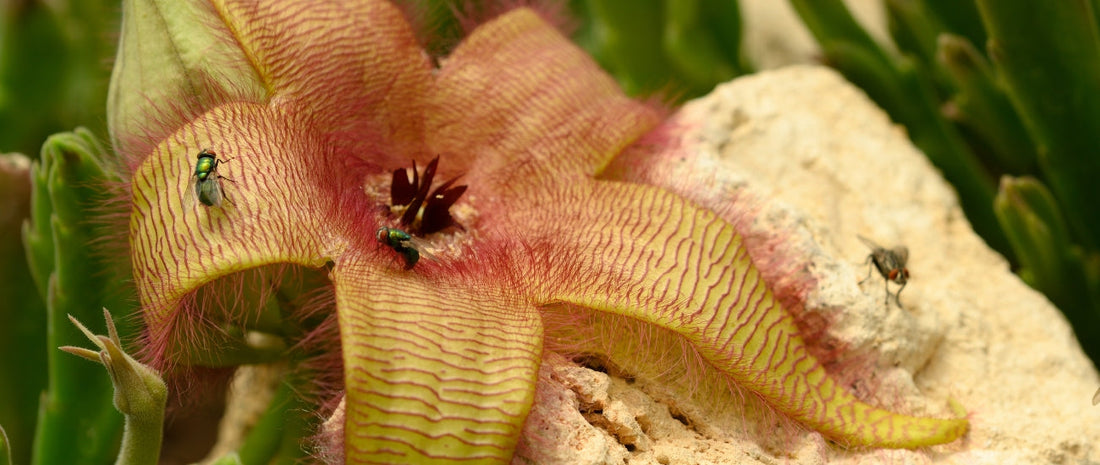Ah yes… the smell of fresh flowers and sunny days is upon us. But what’s that foul scent that’s stopping this reality from being perfect? Well, the answer might surprise you! We associate flowers with their naturally sweet scent, but did you know the flowers that smell terrible to us are releasing this scent for their survival? So let’s get into the science behind naturally stinky flowers and why this scent doesn’t always mean something bad.
Why Do Some Flowers Smell Bad?
If you’ve ever walked past a vase and suddenly caught a whiff of something funky, your first thought might be, “Did something go bad?” Sometimes, yes - it’s just regular old decay. Here’s a short breakdown of why your flowers might be smelling bad:
- Dirty vase water: If you haven’t changed the water in a few days, bacteria start to build up.
- Rotting stems or petals: Once a flower starts wilting, it can give off a sour or musty smell.
- Overripe flowers: Some flowers, when fully opened, can start to smell unpleasant as their natural oils break down.

Here’s the twist: not all funky-smelling flowers are dying. Some of them are meant to smell that way. It’s part of their design. One of the most famous examples is the Titan Arum, also known as the “corpse flower.” It earned its nickname for a good reason… in short, it smells like rotting meat. But it’s not a mistake or a problem, it’s a survival strategy!
So why do some healthy flowers smell so awful? Let’s take a closer look!
The Science Behind Stinky Flowers
While we often think of floral scents as something meant to please us, in nature, the goal is different. Flowers produce scent to communicate with insects, birds, and even small animals. It’s how they attract the help they need to reproduce or protect themselves.
For many plants, that help comes in the form of pollinators. Most flowers use sweet scents to lure in bees, butterflies, or hummingbirds. But not all pollinators are into the sweet stuff.
Why Flowers Release Smelly Scents on Purpose
Some flowers smell bad because they need flies and beetles. That’s right! Flies and beetles are drawn to foul smells like rotting flesh, dung, or mold. So plants like the Titan Arum, Rafflesia, and Skunk Cabbage evolved to smell just like those things. It might sound gross to us, but to a fly or beetle, it’s an open invitation to pollinate.
These strong odors:
- Mimic decaying meat to attract meat-loving insects.
- Guide pollinators straight to the reproductive parts of the plant.
- Guarantee survival by increasing the chance of pollination.
Instead of using bright colors or sugary nectar, these plants rely on their stink - an interesting solution, but it gets the job done.

Wild Flowers That Stink on Purpose
Here are a few natural flowers that proudly stink for survival:
- Titan Arum (Corpse Flower): Native to Indonesia, this plant blooms rarely, but when it does, it releases a powerful smell of rotting meat to attract flies and dung beetles.
- Rafflesia arnoldii: Known as the world’s largest individual flower, it also smells like decay to bring in meat-eating insects.
- Skunk Cabbage: Found in North America, this early spring bloomer gives off a skunky odor to attract pollinators when few other flowers are around.
- Stapelia gigantea (Carrion Flower): Often grown in gardens for its striking star-shaped blooms, this one smells like spoiled meat, too.
These flowers aren’t trying to upset your nose, they’re just calling for backup in their strange way.
House Flowers That Are Naturally Stinky
While most people fill their homes with sweet-smelling plants, a few common house flowers smell bad even when they’re healthy:
- Paperwhite Narcissus: These pretty white flowers may look innocent, but they often give off a strong, musty or even manure-like scent.
- Crown Imperial (Fritillaria imperialis): With a scent some describe as “skunky” or “foxy,” this bold-looking plant uses smell as a natural pest deterrent.
- Orchid Species (like Bulbophyllum): Some orchids use a sour or moldy smell to attract specific pollinators.
These aren’t signs that something’s wrong; they’re just using scent as nature intended. And if you prefer flowers without strong natural odors, you can easily find fast flower delivery services in New York to get fresh, pleasantly scented bouquets right when you need them!
How To Keep Your Home Funk-Friendly
If you don’t have any of these flowers above, then you’re probably safe from any odd smells. But, if you want to make sure that your good-smelling flowers don’t go bad, here are a few easy ways to keep things fresh indoors, even if some of your flowers smell bad:
- Change the water daily: Dirty water is a major reason why flowers smell bad, even if the blooms are healthy.
- Trim the stems: Cutting stems every couple of days prevents rot and improves water intake.
- Keep flowers away from fruit: Fruit releases ethylene gas, which can speed up decay and cause smells.
- Skip the stinky flowers: If you’re sensitive to smell, avoid paperwhites, crown imperials, and certain orchids. Stick to lighter-scented options like tulips or ranunculus.
- Use activated charcoal or baking soda: Placing a small open container nearby can help absorb unwanted odors in the air.
- Ventilate the area: Good airflow helps move any unpleasant smells out of the room more quickly.
Just because some flowers smell bad doesn’t mean you need to ditch them altogether. A little care and planning can go a long way in keeping your home smelling fresh.

Just As Sweet
So the next time you notice your flowers smell bad, don’t be too quick to toss them out. In many cases, it’s just nature doing what it does best: finding clever ways to survive, attract help, or keep pests away. And while not all flowers smell like roses, their role in nature is just as sweet!

